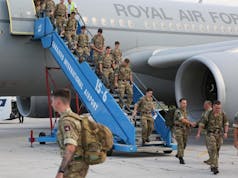The Ministry of Defence (MoD) does not have the powers needed to deal with the fragmentation of its inventory management, it has been claimed.
In a report, the Public Accounts Committee (PAC) warns that long-standing weaknesses remain in the management of the UK armed forces’ supplies and spares for immediate and potential use (collectively described as ‘inventory’).
Problems with inventory management can have serious knock-on consequences for those serving in the armed forces. For example, the PAC’s report highlights that the MoD failed to consider the needs of its medical operations as part of outsourcing commodity procurement to the ‘Team Leidos’ consortium.
“Units faced poor availability of medical inventory as a result and were supplied with items without the shelf life for longer deployments. The Royal Navy in 2022 assessed the situation as presenting a significant risk to life for its personnel if left unresolved, and in 2023 performance for medical had still not improved to the required level.”
The report highlights serious issues with the MoD’s outdated inventory management systems, some of which are nearly forty years old. For instance, the Royal Navy’s base inventory system can record that an item is unserviceable, but not for what reason, meaning the MoD will not know what degree of repair it may need to be useful. The report calls for updates on measures the MoD is undertaking to improve the quality of its inventory data.
The PAC is concerned that new posts established by the MoD to bring coherence to inventory management do not have the powers needed to deal with the fragmented system, instead relying on influencing to improve the situation. While a £2.5bn project aimed at resolving historic issues faced in managing inventory is in place, the PAC is sceptical about MoD’s ability to realise these complex and ambitious plans in time, given both its patchy track record and staffing gaps of around 25% in the relevant programmes.
Given that future conflicts may require sudden surges in demand and industrial capacity, which industry may need support to provide, the report also seeks information on how the Government intends to work with industry to ensure greater resilience in its inventory management.
Dame Meg Hillier MP, Chair of the Committee, said:
“Our brave armed forces personnel put themselves in harm’s way in defence of our nation, and deserve to expect that the equipment they require to do so will be there when they need it. Our Committee warned over a decade ago of waste and fragmentation in the MoD’s supply systems, and our report finds that many of those problems remain unresolved and without the right powers to address them. We were also concerned to hear as part of our inquiry that a contract for a £515 million programme to address data gaps was awarded to a large defence prime contractor without a competitive tendering process. The MoD must of course continue to do everything in its power to address these issues at pace while ensuring value for money. Blind spots in the system must be brought into sharp focus, and lessons from the war in Ukraine and the pandemic urgently implemented to ensure resilient supply. We live in an increasingly volatile and unpredictable world. The future must not find us under-prepared.”
PAC report conclusions and recommendations
The MoD’s Chief of Defence Logistics and Support does not have the powers needed to deal with the fragmentation of its inventory management.
Front Line Commands historically managed their own inventories, while Defence Equipment and Support (DE&S) manage the MoD’s central warehousing and the procurement of much of its inventory. This has created a complex organisational set-up with inefficient working practices. The MoD established the post of Chief of Defence Logistics and Support (CDLS) and the Defence Support function in 2019 to cohere MoD’s inventory management, with the aim of implementing strategy, policies and standards across the MoD and its defence organisations. We are concerned, however, that CDLS does not have the power to direct these organisations, instead relying on influencing to improve inventory management. A recent internal review found that Defence Support and DE&S need to be much more integrated, and DE&S’s past behaviours have not been conducive to collaboration and external challenge. The MoD considers that the behaviours and culture across defence have already started to become more integrated, though it accepts that the change needed may take years, and is looking at how to grant CDLS the power of authority to direct the single services to take action or not.
Recommendation – In its Treasury Minute response, the MoD should set out the steps it has taken to provide CDLS and the Support function with the right levers and authority to implement its Support Strategy to achieve the 2025 strategic outcome “waypoints” (towards the 2035 goals).
The MoD’s inventory management systems remain outdated, and the quality of its data limits its ability to understand its inventory.
MoD’s inventory management has faced long-standing issues with its many legacy IT systems, which have limited functionality and reinforce the fragmentation of its inventory management. While it has reduced the number of Support systems from around 250 in 2010 to 89 today, the two base inventory management systems used by the Army and Royal Navy respectively are nearly 40 years old. The MoD acknowledges that, while its visibility of its inventory is generally good, its system functionality can prevent staff from having a deeper understanding of it. For example, the Royal Navy’s base inventory system can record that an item is unserviceable, but not for what reason, meaning the MoD will not know what degree of repair it may need. In 2010, the MoD entered into a £800 million contract with Boeing Defence UK called Future Logistics Information Services (FLIS) that was due to run until 2022. However, in late 2020 the MoD signed a five-year contract extension worth £515 million called “Bridging the Gap”, which the MoD explained at the time would “provide capability that Bridges the Gap between the FLIS contract and the future long-term strategic solution, known as the Business Modernisation for Support (BMfS) project”. The MoD’s short-term plan for Bridging the Gap is to move the Army and Royal Navy onto an upgraded version of the Royal Air Force’s more modern inventory system. We do not see, however, how this step alone will address the existing gaps in its data. We are also concerned to hear that the MoD awarded the contract for this £515 million programme to a large defence prime contractor without a competitive tendering process.
Recommendation – Within six months, the MoD should provide an update to us setting out progress against its plans for the Bridging the Gap project, as well as any other measures it is undertaking to improve the quality of its inventory data. This should specifically address the likelihood that a further contract extension will be required to complete the Future Logistics Information Services work, and the expected cost and duration of any such extension.
The MoD’s transformation plans are complex and ambitious, but its track record means we are sceptical about its ability to achieve them.
The MoD has put in place the £2.5 billion Business Modernisation for Support (BMfS) programme to upgrade its legacy IT infrastructure and introduce aligned business processes across its bodies. This programme is intended to resolve many of the historic issues the MoD has faced in managing its inventory, however it is highly complex: transforming services for around 65,000 users across Defence whilst maintaining operations throughout. The MoD’s track record in delivering business and digital transformation is patchy, and the Committee is concerned about the level of skills and personnel available to MoD to manage these programmes. The MoD faces staffing gaps of around 25% across both BMfS and its Future Defence Support Services (FDSS) programme, which aims to find the best commercial arrangements for inventory management from 2028. While the MoD told us it has brought in digital skills for BMfS, it acknowledged that the staffing gaps create risks for FDSS, though it is confident it can still meet the 2028 target delivery date through sensible prioritisation.
Recommendation – In its Treasury Minute response, the MoD should write to us setting out progress on its Support transformation programmes, how it is ensuring it has the right skills and experience to deliver them, and how it will engage with industry in doing so.
MoD will need to work closely with industry to ensure resilience in its supply chains.
The MoD outsourced its central warehousing and the procurement of some of its commodities – food, clothing, general and medical supplies – to a consortium under the “Team Leidos” banner through the Logistics Commodities and Services Transformation (LCST) contract in 2015. This has been successful overall, forecast to generate financial efficiencies of £403 million over the life of the contract and has increased the agility of MoD’s supply operations. The MoD is looking at incorporating the learning from the LCST contract into its £1.8 billion FDSS programme for future contracts which will replace LCST in 2028. The CDLS admits FDSS is a large, complex piece of work which he is expecting will require external advice. FDSS provides a once in a generation opportunity to merge important inventory-related software contracts into a single programme. Recent events, such as the war in Ukraine and covid-19, have brought about a reassessment of how the MoD should manage its inventory, away from prioritising efficiency to ensuring greater resilience. Ukraine and previous conflicts have also highlighted the importance of protecting support networks. For example, the MoD stated that throughout its recent operations in Afghanistan, 60% of casualties were among personnel involved in force protection of lines of communication, such as convoys of fuel or stores. Future conflicts may require sudden surges in demand and industrial capacity, which industry may need support to provide. MoD told us it helped develop a North Atlantic Treaty Organisation (NATO) defence production action plan to signal demand clearly to industry and the MoD plans to invest around £2.4 billion in strengthening supply chains. In the longer term it intends to create an “always-on” demand pattern to create a more robust supply chain.
Recommendation – In its Treasury Minute response, the MoD should update on its plans for how it intends to work with industry ensure greater resilience in its inventory management, including its £2.4 billion of investment in supply chains.
- Within six months, the MoD should inform the Committee by letter of the lessons learned from its review of the LCST contract and how it will implement these.
- Within twelve months the MoD should provide a progress report to the Committee on its plans for merging the LCST contract and a number of similar contracts into FDCC programme. In particular, the MoD should set out how well the IT software programmes are being developed to support the logistics consolidation.
The MoD failed to consider the needs of its medical operations in outsourcing commodity procurement to Team Leidos and this has created significant risks for front-line personnel.
Since the LCST contract began, the inventory needs of front-line medical personnel have not been well served. In particular, units have faced poor availability of medical inventory and been supplied with items without sufficient shelf life for longer deployments. In 2022, the Royal Navy assessed that, if unresolved, the situation would present a significant risk to life for its personnel. This issue arose because the contract applied a general target across all commodity supply. This meant that lower performance in supplying medical inventory (which generally requires higher performance than other commodities) was masked by better performance elsewhere. Furthermore, there is granularity within what is needed for certain elements of medical inventory: the MoD cited 90%, 95% and 98% inventory level requirements for different medical equipment. For the average inventory of “fast-moving commodity type medical items”, the MoD told us that Team Leidos was now achieving the 92% level “on a regular basis”. From 2019, the MoD changed the incentivisation in the contract to hit time targets and deliver new projects and equipment faster, which improved the situation but still not to the required level. However, in 2023 because performance for medical had still not improved to the required level, the MoD approved further improvement initiatives which will ultimately require it to pay the supplier a further £13.2 million.
Recommendation – In its Treasury Minute response, the MoD should write to us setting out how it will ensure that the requirements of medical personnel will be properly addressed in its future inventory management arrangements, and how it will resolve risks more quickly in future. This should include providing data on a quarterly or monthly basis of how performance in the supply of medical inventory has changed over the life of the LCST contract, including performance against target inventory level requirements for different sub-sectors of medical equipment as well as the overall medical equipment inventory target. Alongside this, the MoD should set when it expects to consistently achieve each of these targets.
While the MoD has reduced the amount of stock it holds, it still holds large amounts of excess and unserviceable inventory.
From 2011 to 2023, the MoD told us it achieved a 25% reduction in the net book value of its inventory, which it reduced from £16 billion to £12 billion. However, it is still holding substantial amounts of inventory that is unserviceable, overstocked or beyond the service date of its related platform. The MoD argues that there are many complex reasons for these build-ups of stock. For example, unserviceable inventory may still be useful if repaired, and other items are overstocked for contingency scenarios. It also stated that activity supporting the front line will always take priority over managing disposals, and the move towards building resilience will increase the level of inventory being held in future. Nonetheless, it acknowledged that its decision-making needs to be informed by better data; for example, missing data on why inventory is unserviceable makes it difficult to understand what should be disposed of. The MoD has now put in place projects to target disposals, but these are disparate and some areas, particularly the Royal Air Force, have achieved more than others.
Recommendation – In its Treasury Minute response, the MoD should set out how it is improving its ability to understand which inventory items need disposing of, and ensuring this is done so consistently. It should also set out details of any targets it has to reduce the amount of the overall inventory and particular areas.














Feeding the MIC fat cats with lucrative contracts again? Half a billion..
Did these issues exist when logistics and supply were in house? The services all had logistic commands, overseen by places such as the RAF Computer Centre at Stanbridge?
Has privatisation achieved any real savings?
NO.🙄
Savings are achieved through staff reduction , poorer terms and conditions for new starters and general wage stagnation . A well know out outsource company reduced its Christmas meal allowance for the second time. Savings of 5% to !5% are claimed however this does not account for loss of tax revenue through tax avoidance accounting !
Danielle, short answer, No!
No. It’s like councils outsourcing pothole repairs. They previously spent £1m, then outsourced it to a company that bid £800k and claimed a £200k saving. But the outsourced company needs to make a profit, so now we only get £600k of repair work. The MOD outsourcing recruitment has been another shambles.
Or the out source comapny bought better kit that allow them to do more with less, If the private sector is so bad then why have things like car factories improved exponetially over the past 100 years using robots and automation? The very reason we have an armed forces is becuase of the private sector, anything run by the government is an overhead and is paid for by taxing the private sector worker or profits from private sector companies.
The problem is the privitisation is not competitve and the MoD is useless at writing contract. You just don’t see these issue with say an airline when they contract out because they just much better at managing the contractor and have much better contracts. Another route casue is the contractor is almost government, Sir John Parker eluded to this in the ship building inductry that ship yard with government contracts were less efficient than those who competed for commericial work.
You may well find the same contractor delivering a far better service in the commercial sector.
Lastly I doubt bring anything back in house will help, inevitably what happens the same bunch get employed by the MoD so nothing actually changes. They just getting better pensions and and are harder fot get rid of.
Get rid of Capita, chunks of the MOD and woke divergence, we might have an army.
Do these civvy companies who do the outsourcing advocate a ‘Just In Time’ philosophy of inventory management rather than ‘Just In Case’?
I dread to think how much kit required for General War has been binned just because it hasn’t been issued for ages eg. stuff like boots, uniforms, weapons and vehicles for the Regular Reservists!! Sorry to recycle that dit!
The way inventory management sytem works is you have life limited invnetory, so that has a shelf life and you’ll have to either relife it or dispose of it so thats food, meds, rubber items or even munitions anything that can perish. Then theres slow moving items but it wouldn’t be the civvies running the system that would decide when to chuck slow moving inventory, thouse decision will be made by the MoD, the civies will just highlight them in the report saying you’ve not used these for ages do you want to scrap them.
As for reordering this is also a feature of the system, when levels hit a certain reorder point then a PO is rasied to bring level back up, the reorder point is calculated using consumption and lead times,. Again I doubt the civvies set these reorder point alone and MoD have an active role in defining these. If you’re suppliers don’t hit the lead time then you need to take them to task or even apply a penatly clause (lol). Again the supply contract is most likely with the MoD and therefore I doubt their any late deleivery penatly clause due shoddy MoD contracting.
I very rarely come accross a commercial operation that has any significant inventory issue, they know how to properly manage their inventory and supply chain.
Thanks mate. I left the army in 2009 and this is now a new era for inventory management.
Not sure that commercial inventory management is totally 100% to the satisfaction of the customer – there are often some empty shelves in supermarkets and I often have to order up a technical part (ie for the car, washing machine etc) as it is not in stock at the retailer and which takes ages to arrive there.
Do commercial companies really understand the very different philosophy required for military inventories? Perhaps its OK if the riding instructions set by the MoD on them clearly reflect the different military usage and detail the stock levels required etc
With a sparser defence industrial base in the UK and the greater complexity to manufacture everything from ammunition to tank spares – I do hope that we can surge to meet General War in time – Ukraine had barely 4 months notice of the strong possibility of invasion.
The principles of inventory management don’t change if its military its still supply and demand. If I’m planning a maintenance check on a military vehicle that should be in the system with all the spares required to do the check. Failure mode analysis should done also to cover parts that might fail outside routine checks. This will provide the system with data it needs to have the parts on the shelf at the right time. Most of the problems arise because of the wrong data us in the system example every check you also find an oring needs replacing this is not on the work order as required part for the check. The parts list for that check.should be updated to ensure the oring is included. Also most of the big software companies have an Airspace and Defence divisions, which usually employ exmilitary personnel to advise them on any subtle differences required for the military.
Another example is all MRO providers will use a commercial system even when they repair a military part. So RR will not have 2 system to MRO trent engines and Eurofighter engines. So commercial systems 100% work.
If we want ramp up military capacity we be best turning to a company like JCB who can build heavy equipment efficiently using the latest manufacturing techniques. Yes they’d need to team with others on design but if we need volume then a company like JCB will be far more capable of setting up manufacturing cells and lines to increase output. The worry is companies like JCB up sticks and move production abroad because we over regulate industries.
Thanks mate. You always have a good number of useful points. Perhaps I should be reassured that a commercial company managing a military inventory would not apply JIT methodology.
They would never apply it without MoD approval. JIT has its place but only where supply and lead time is guaranteed. An example might be paint thinners where it available readily and in constantproduction. Also JIT doesn’t mean you wait until you’re to the last item then replenish, you can still hold some buffer stock.
There is a flip side to JIT I remember the South African airforce had parts from airframes that had been scrapped 10 years before. So they were paying to store parts which were of no use to them!
Every £1 spent on an outsourced solution is a £1 not being invested in providing the solution for those the system was established for! I am of that belief, when my department had its internal services transferred to a private outsourced solution provider. I am steadfast in thinking the government and its departments must do certain tasks for themselves.
My dept had high morale and retention of experienced staff who did its job efficiently and quietly. The Inspectorate office reports time (and in the proceeding decades going back to the early 1980s) and again that we were operating within our remit in such a manner that produced a service that did its job and was value for money. When I first joined it, if you needed equipment or other items to do the job, there was a no-fuss method of getting it. Today, half the old internal services are contracted out. We are constantly screaming about some of the staff the service provider uses, plus the quality and haphazard method of delivering them. From the minor building issue where a quick call to the site staff who would pop up, look at the issue and get the leak/drip/dirt fixed/cleaned up. Now we have to fill out a form, wait up to 48 hours for someone to come and look at it, then arrange for the repair etc. We have gone from an hour’s service to sometimes thinking” They did that quickly” if done within 7 days. Our transport needs are complex and admittingly, the pool was big with some vehicles not moving for 10 months of the year. That service was contracted out and instantly the people providing it created havoc. Add to that the problems caused by service providers staff no longer working for the department, resulting in having to sanitise entire areas or move the team to a different room, thus creating other issues becausethey were away from their desks that contained the tools and information they needed. It drove our efficiency down so much, we got our first warnings in the inspectorates report. Staff have been calling it a day and retiring once they hit the pension age and getting out of dodge ASAP, they don’t want to fight a third party to do their job.
Be it the MOD, NHS, Law Enforcement, Justice, Prisons, Schools, Nursing Homes, Social Services etc. The system has to be run to do the job it’s supposed to do. In the case of the MOD, it’s to protect the nation and its citizens in the best way possible. As for costs, there should be a robust system of checks and balances to produce the best effort within its brief.
You hit the nail on the head there Graham. Many of our services went from going with a chit to get the equipment that may have been sitting there unused for months, to a JIT system whereby they provided it at the very last minute (often it not arriving on time) because they were renting it from a third party. Okay, the old system meant we had an inventory that had a stock value that always depreciated. To one where they said taxpayers money was no longer being waisted by buying items that were seldom used or were subject to becoming obsolete and scrapped delivering poor value for money. Our problem was a good percentage of the equipment we used had been “tailored” to suit our needs and was no longer suitable for sending back to the owners (a bit like “you break it, you pay for it”).
Let’s highlight the problem when the government passes the responsibility to profit making private companies that causes the problems just look at the state of mili tary housing sold off to a private investor he made his money from the expense of the hard working military personnel. Group 4, serco, paid millions but they are not fit for purpose.
Group 4 could not provide the security for the 2012 London Olympics despite being hired to do so, so MoD was asked to provide soldiers at the 11th hour. I remember that dit well.
They also couldn’t run prisons but they still keep getting taxpayers money. I reckon some MPs will be getting a consultation jobs with these useless companies. when they are finished in politics.
A major problem with outsourcing is that as soon as you do “it”, you have lost control of “it”. The company to which “it” has been outsourced see “A Fat Profit” arriving, and you end up with a chain with broken links.
Re-joining the links becomes difficult if not impossible and the only answer is to bring “it” back in-house, but no one has the b aw lls to do it – because if the customer (you chaps on the front line) don’t get it, it saves us money, so make the best of what you have.
All very sad when we stomp around the world telling everyone how good we are! Our forces are amazing people, but our politicians are cr * p.
1938 all over again – we know its going to happen sooner or later but we have no one prepared to step up to the plate and sort it.
Broken links are like when the outsourcing company sends out 98% of the torque wrenches for calibration and then wonders why it takes months to get them back as they did not pay the invoice . The MOD used to do them in house calibration department with a couple of days turn around or loan item if needed . No doubt tax advantage as can be claimed as a business expense.
As these old systems are text based I’m slightly lost as to why another couple of columns can’t be added or how it cost even vaguely cost £55m to do that.
I’d cheerfully do it for £25m which would make me about £23m profit. Using an established database.
This isn’t hard…..not at all…
The problem is time and time again you see the civil service miss manage the whole thing then everyone blames the contractor. But the real cause is the civil servants can’t actually control the contractor or write contracts that enforce proper performance.
Put simply you can have the same contractor working is say airline or oil and gas and you won’t see the same issues, becuase the commercial sector would not let it happen, head would role. That doesn’t happen in the civil service.
I agree.
We would be all over it.
The problem is manifold.
Scope creep
Good ideas club
Limited number of contractors.
The last issue is a negotiating sticking point if the contractor is made to swallow too much poison they shrug on the next tender or simply add that cost on top.
If you genuinely can leave a contact alone, as T31 was meant to be, then it is very possible to have fixed prices.
I’m routinely involved in huge domestic projects (£m’s) where the variations are of greater value than the contract sums.
Fiddling with specifications is a very expensive pastime. We never make good money on those projects as the inefficiencies compound
I find the one man contractors are probably the worst they have to maximise earnings so promote changes to increase their scope to get paid. They generally don’t like it when I turn up and put in proper process around scope change 🙂
It cuts both ways.
One man bands can issue a try-it-on invoice. A lot of the time it gets paid on the basis that ‘they will walk off the job’….
With larger outfits there can be whole processes and departments generating claims.
It all depends on contact types / specifications and how good they are / how little they move.
Yet another addition to the dossier of greed and corruption, fuelled by outsourcing to ‘preferred suppliers’, who specialise in monopolising the marketplace.